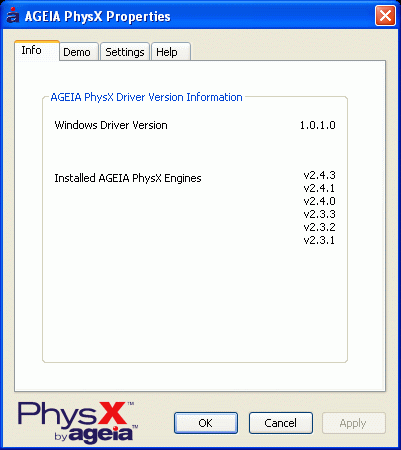Can Ageia's PhysX Card Bring Real-World Physics to Games?
Installing The PhysX Card, Continued
The older versions of the PhysX engine remain installed in the system and are displayed in the driver's information section.
The card's small fan, which is lit by blue LEDs, is barely audible during normal operation. Since the card is built like an AGP card, the components and its fan are turned downward in the case once installed. In our second test setup, the Ageia card was mounted vertically, producing an unpleasant whir from the fan.
Performance And Power Consumption
Of course, the big question is whether the Ageia card really does unburden the CPU from the physics calculations. The answer here is both yes and no. With a PhysX card installed, more details are visible in Ghost Recon Advanced Warfighter. These additional details are calculated by the PPU and don't create more load for the CPU. However, the downside is that these added effects also have to be rendered by the graphics card, which taxes performance, albeit marginally. In short, more details equal lower frame rates. We ran the performance test on two platforms to determine what kind of impact, either positive or negative, physics acceleration has on overall performance. In both cases, we saw only a minor performance hit.
Performance test Ageia PhysX card with Ghost Recon Advanced Warfighter (1024x768, max.)
| Intel 2.4 GHz, GeForce 6800 GT | Average | Minimum | Maximum |
|---|---|---|---|
| With PhysX Card | 17.3 fps | 11 fps | 20 fps |
| Without PhysX Card | 17.7 fps | 14 fps | 20 fps |
| Intel Dual Core 3.1 GHz, Radeon 1900 XTX | Average | Minimum | Maximum |
|---|---|---|---|
| With PhysX Card | 55.7 fps | 42 fps | 67 fps |
| Without PhysX-Card | 58.3 fps | 49 fps | 67 fps |
We measured the card's power consumption in the more powerful system based on the dual-core Intel processor and the Radeon X1900 XTX. The card increases the system's overall power consumption by 40 watts. These measurements represent peak values.
Power Consumption of Ageia's PhysX Card
| Intel Dual Core 3.1 GHz, Radeon 1900 XTX | 2D-Windows | 3D-Action |
|---|---|---|
| With PhysX Card | 185 watts | 390 watts |
| Without PhysX Card | 146 watts | 350 watts |
Get Tom's Hardware's best news and in-depth reviews, straight to your inbox.
Current page: Installing The PhysX Card, Continued
Prev Page Installing The PhysX Card Next Page PhysX Card Vs. Software Physics